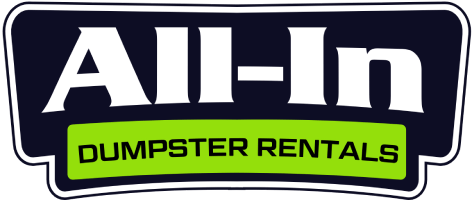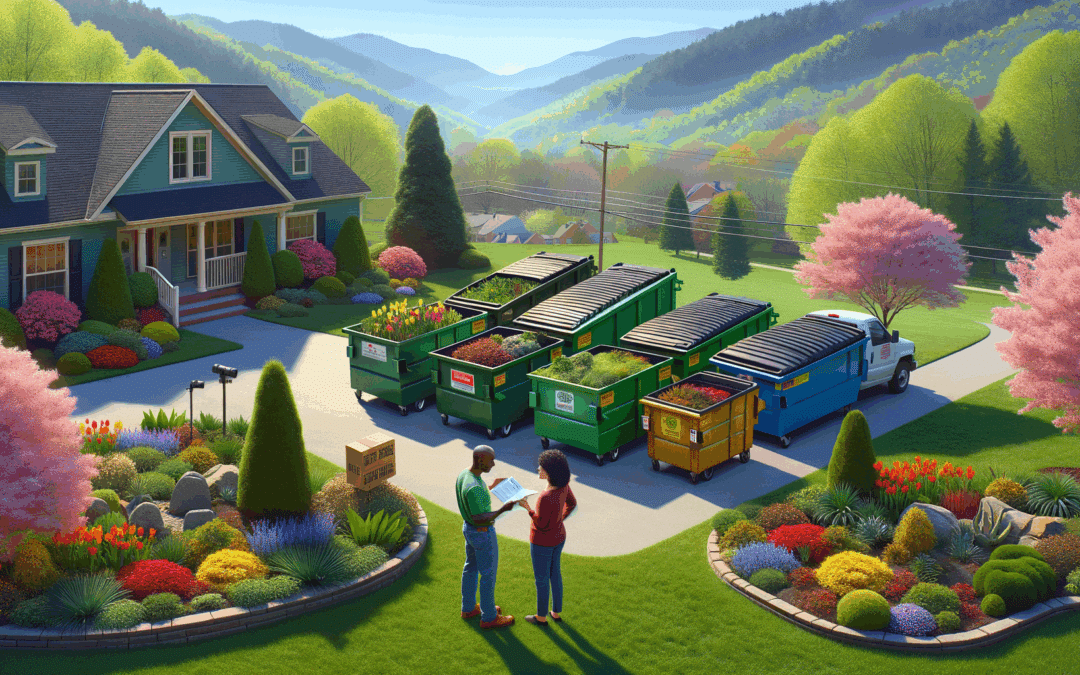When the seasons change in Asheville, our yards transform with them. From spring pruning to summer garden renovations and the notorious fall leaf cleanup, Western North Carolina homeowners know that landscaping creates an astonishing amount of yard waste. What many don’t realize is that choosing the right dumpster can make all the difference between a smooth project and days of frustration.
As Western North Carolina’s changing seasons paint our mountains with vibrant colors, they also fill our yards with material that needs proper disposal. Having served Asheville and surrounding communities like Hendersonville, Waynesville, and Weaverville since 2021, we’ve seen firsthand how proper waste management makes landscape projects much easier for local homeowners.
Why Typical Disposal Methods Fall Short
Many Asheville homeowners initially try to manage yard waste with regular trash cans or those paper lawn bags from the hardware store. These methods quickly show their limitations when you’re dealing with more than a few branches or a small patch of sod.
The challenges become obvious when you consider our region’s unique landscaping needs. The lush vegetation that makes our Blue Ridge area so beautiful also means we generate more yard waste than many other parts of the country. Add to this Asheville’s commitment to environmental responsibility, and proper disposal becomes even more important.
Bagging leaves might work for small yards, but what about when you’re removing invasive bamboo that’s taken over your Montford neighborhood backyard? Or replacing that sloped lawn in West Asheville with native plants? These projects create substantial waste that requires a more robust solution.
Understanding Different Types of Yard Waste
Before selecting a dumpster, it helps to understand what type of yard waste you’re dealing with. Different projects generate different materials, each with specific disposal requirements:
Green waste includes grass clippings, leaves, and fresh plant material. This biodegradable material is relatively lightweight but can be bulky and decomposes quickly, sometimes creating odors.
Woody waste consists of branches, tree trunks, and shrub removals. This material is heavy, dense, and often awkwardly shaped, making it particularly challenging to dispose of through regular means.
Soil and sod removal creates exceptionally heavy waste. When Asheville homeowners renovate gardens or level areas for patios, the weight of dirt can add up remarkably fast.
Mixed landscaping debris might include a combination of materials, possibly with some non-organic elements like landscape fabric, edging, or old planters.
Here in Western North Carolina, we often see distinct seasonal patterns. Spring brings pruning waste, summer features renovation debris, and fall is dominated by leaves—mountains of leaves, especially if you’ve got oak trees on your property!
Matching Dumpster Size to Your Project
When Asheville homeowners call us about landscape projects, one question always comes up: “What size dumpster do I need?” The answer depends on your specific project scope, but here are some general guidelines:
10-yard dumpsters work well for smaller projects like pruning several large shrubs, clearing a small garden bed, or handling typical fall leaf cleanup for a standard lot. With their compact footprint, these fit well in tighter spaces common in neighborhoods like Kenilworth or North Asheville.
13-yard dumpsters strike a balance that works for medium-sized projects. They’re perfect when you’re removing a few small trees, renovating larger garden beds, or handling extensive seasonal cleanups, particularly on those larger lots in areas like Fairview or Fletcher.
15-yard dumpsters provide the capacity needed for major landscape renovations, removing multiple trees, or clearing substantial brushy areas—something many Asheville homeowners face when maintaining properties that border natural areas.
Remember that yard waste often takes up more space than you might estimate. That hedge removal might seem modest, but once branches are cut, they don’t stack neatly and can quickly fill a smaller container. We’ve seen many Asheville homeowners surprised by how quickly their yard waste accumulates.
Weight Considerations for Yard Waste
While size matters, weight is equally important when selecting a dumpster for landscaping projects. Yard waste weight varies tremendously by type:
Dry leaves and brush are relatively lightweight, meaning you can fill an entire dumpster without approaching weight limits. However, the moment soil enters the equation, things change dramatically.
Wet soil is remarkably heavy. Even a small amount of excavated dirt from your Asheville yard can quickly approach weight limits. This is particularly important in our region, where clay soils common in many neighborhoods become exceptionally heavy when wet.
For context, a cubic yard of soil can weigh between 1,500-2,200 pounds depending on moisture content and composition. That means even a small garden renovation involving soil removal needs careful planning.
Tree removals present their own challenges. While branches might be manageable, stumps and large trunk sections are extremely dense. We always advise Asheville customers to discuss these specific items before disposal.
Seasonal Considerations in Western North Carolina
Timing matters when planning landscape waste disposal in our region. Western North Carolina’s seasonal patterns influence both the type of projects you’re likely undertaking and the conditions for waste removal:
Spring brings rapid growth and often the first major yard cleanup of the year. The combination of winter debris and new pruning can create substantial waste. Spring showers also mean materials might be wet and heavier than expected.
Summer is prime time for major landscape renovations. The dry conditions are ideal for working but can make dust containment important when loading debris. In Asheville’s typical summer pattern, afternoon thunderstorms can suddenly soak materials, adding weight.
Fall means leaves—endless leaves if you’re surrounded by Asheville’s abundant hardwood trees. While individual leaves are light, they compress over time, creating surprisingly dense layers. A dumpster that starts with fluffy leaves will settle substantially.
Winter might seem quiet for landscaping, but many Asheville homeowners use this time for major tree work and structural changes while plants are dormant. Winter storms also create cleanup needs throughout the season.
Planning your dumpster rental to align with your project timeline and weather forecasts can make a significant difference in efficiency. Nothing slows down an Asheville landscape project like having nowhere to put the debris.
Environmental Considerations
Asheville takes pride in its environmental consciousness, and proper yard waste handling reflects those values. Unlike regular household trash, organic yard waste can often be processed for beneficial reuse:
Much of the yard waste collected in Western North Carolina can be composted or mulched rather than sent to landfills. This returns valuable nutrients to the soil and reduces methane emissions from landfills.
When you rent a dedicated yard waste dumpster, your materials are more likely to be properly sorted for composting or other appropriate processing. This is especially important in our ecologically conscious community.
However, certain invasive plants common in our region (like certain bamboo varieties, kudzu, or Japanese knotweed) may require special handling to prevent spreading. These shouldn’t go into standard yard waste processing.
Similarly, soil from areas with known contamination issues needs appropriate disposal. This occasionally affects older properties in Asheville where historic land uses might have introduced contaminants.
Preparing Your Property for Dumpster Placement
The success of your landscaping waste disposal starts with proper dumpster placement. Given Asheville’s varied topography and mix of urban, suburban, and rural properties, this requires careful consideration:
The ideal location provides easy access for both you and the delivery truck. In hilly areas like those in North Asheville or Kenilworth, finding a relatively flat spot is essential for safe placement and use.
Consider proximity to your work area to minimize the distance for carrying or wheelbarrowing debris. This becomes especially important when managing heavy materials like soil or stone.
Protect your driveway or lawn by requesting plywood placement beneath the dumpster, particularly important given the weight involved. After heavy rains common in our mountains, soft ground can be easily damaged.
Many Asheville neighborhoods have specific HOA rules about dumpster placement and duration. Check local regulations before scheduling delivery, especially in managed communities like Biltmore Park or Reynolds Mountain.
Loading Tips for Maximum Efficiency
How you load your dumpster can significantly impact how much material it holds. Based on years of helping Asheville residents with their landscape projects, here are some practical loading strategies:
Start with the bulkiest, most awkwardly shaped items first. Large branches or root balls can be positioned to minimize wasted space.
Break down larger items when possible. Cutting branches into smaller sections allows for more compact stacking and better space utilization.
Distribute weight evenly throughout the container to prevent shifting during transport. This is especially important given the winding roads that serve many Asheville neighborhoods.
Avoid overfilling above the rim of the container. Materials should not extend beyond the top of the dumpster, as this creates safety hazards during transport through our mountainous terrain.
Keep the dumpster covered with a tarp during rain, which is unpredictable in Western North Carolina even during supposedly dry seasons. This prevents water accumulation that adds unnecessary weight and cost.
What Not to Place in Yard Waste Dumpsters
While yard waste dumpsters are versatile, certain materials don’t belong in them. These restrictions help ensure proper processing and environmental safety:
Treated lumber, painted wood, or manufactured wood products should not go into yard waste containers, as they contain chemicals incompatible with composting processes.
Trash, household debris, or construction materials must be kept separate from organic yard waste to ensure proper processing.
Hazardous materials like pesticide containers, fertilizer bags, or chemicals should never be placed in any dumpster without special arrangements.
Some particularly problematic invasive plants in our region may require special handling instructions—always mention these when ordering your dumpster so we can provide proper guidance.
Planning Your Timeline
Successful landscape projects in Asheville require good timing, especially regarding waste removal. Based on our experience serving Western North Carolina communities:
Schedule your dumpster delivery 1-2 days before your project begins to ensure you have it when needed. This is especially important during busy seasons when availability can be limited.
Consider rental duration that gives you some flexibility. Weather in the mountains can change quickly, potentially delaying your work. Having an extra day buffer can reduce stress.
For extended projects, ask about swap-out options where a full container is removed and replaced with an empty one. This prevents work stoppages while waiting for disposal.
Remember that autumn leaf season and spring cleanup times are our busiest periods in Asheville. Book further in advance during these peak times to ensure availability.
Making Your Asheville Landscaping Project Smoother
After helping countless Asheville residents with their yard transformations, we’ve learned that the right preparation makes all the difference. Your landscape vision deserves the proper support to become reality.
Whether you’re restoring a natural area in Montford with native plants, creating a drought-resistant garden in West Asheville, or simply cleaning up storm damage in Weaverville, having the right waste solution matters.
By matching your dumpster size to your project needs, preparing properly, and following these guidelines, you’ll find your landscaping work becomes significantly more manageable. The mountains surrounding us are testament to natural beauty—your yard can reflect that same harmony with the right care and planning.
Your outdoor space is worth the investment, and proper waste management is an essential part of creating and maintaining that special Asheville charm that makes our homes unique.

